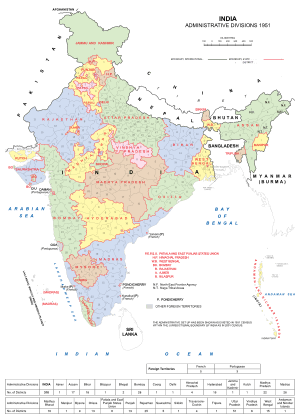Bombay Legislative Assembly election, 1952

Elections to the Legislative Assembly of the Indian state of Bombay were held on March 26, 1952. 1239 candidates contested for the 260 constituencies in the Assembly. There were 1 three-member, 47 two-member constituencies and 212 single-member constituencies. [1]
Results
| Political party | Flag | Seats Contested | Won | % of Seats | Votes | Vote % | |
|---|---|---|---|---|---|---|---|
| Indian National Congress | |
313 | 269 | 85.40 | 55,56,334 | 49.95 | |
| Socialist Party | 182 | 9 | 2.86 | 13,30,246 | 11.96 | ||
| Peasants and Workers Party of India | 87 | 14 | 4.44 | 7,17,963 | 6.45 | ||
| Scheduled Caste Federation | 37 | 1 | 0.32 | 3,44,718 | 3.10 | ||
| Kamgar Kisan Paksha | 33 | 2 | 0.63 | 2,48,130 | 2.23 | ||
| Communist Party of India | |
25 | 1 | 0.32 | 1,59,994 | 1.44 | |
| Krishikar Lok Party | 16 | 1 | 0.32 | 1,07,408 | 0.97 | ||
| Independent | 427 | 18 | 5.71 | 19,17,574 | 17.24 | ||
| Total seats | 315 | Voters | 2,19,04,595 | Turnout | 1,11,23,242 (50.78 %) | ||
State Reorganization
On 1 November 1956, under States Reorganisation Act, 1956, Bombay state was enlarged by the addition of Saurashtra state and Kutch state, the Marathi-speaking districts of Nagpur Division of Madhya Pradesh, and the Marathi speaking Marathwada region of Hyderabad. The state's southernmost Kannada-speaking districts of Dharwar, Bijapur, North Kanara and Belgaum (excluding the Chandgad taluk) were transferred to Mysore state, while Abu Road taluk of the Banaskantha district was transferred to Rajasthan.[2] Hence the constituencies increased from 315 to 396 in 1957 elections.
See also
References
- 1 2 "Statistical Report on General Election, 1951 : To the Legislative Assembly of Bombay" (PDF). Election Commission of India. Retrieved 2014-10-14.
- ↑ "Reorganisation of States, 1955" (PDF). The Economic Weekly. October 15, 1955. Retrieved July 25, 2015.